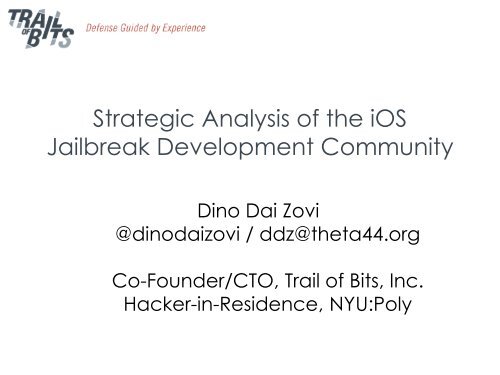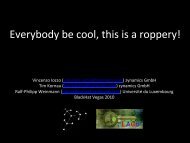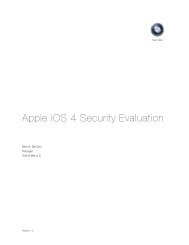Strategic Analysis of the iOS Jailbreak Development ... - Trail of Bits
Strategic Analysis of the iOS Jailbreak Development ... - Trail of Bits
Strategic Analysis of the iOS Jailbreak Development ... - Trail of Bits
You also want an ePaper? Increase the reach of your titles
YUMPU automatically turns print PDFs into web optimized ePapers that Google loves.
<strong>Strategic</strong> <strong>Analysis</strong> <strong>of</strong> <strong>the</strong> <strong>iOS</strong><br />
<strong>Jailbreak</strong> <strong>Development</strong> Community<br />
Dino Dai Zovi<br />
@dinodaizovi / ddz@<strong>the</strong>ta44.org<br />
Co-Founder/CTO, <strong>Trail</strong> <strong>of</strong> <strong>Bits</strong>, Inc.<br />
Hacker-in-Residence, NYU:Poly
Why?<br />
• <strong>Jailbreak</strong>s and attacks share many <strong>of</strong> <strong>the</strong><br />
same underlying <strong>of</strong>fensive technologies<br />
• Vulnerabilities, exploits, evading and<br />
disabling security mechanisms, “rootkits”<br />
• <strong>Jailbreak</strong>er communities are more<br />
observable than attacker communities<br />
• The jailbreak communities develop and<br />
release jailbreaks in full public view<br />
• Malicious attackers develop and<br />
“release” <strong>the</strong>ir attacks as quietly as<br />
possible
<strong>Jailbreak</strong>s vs. Attacks<br />
• Injection vector<br />
and an “unte<strong>the</strong>r”<br />
• Allow OS “mods”,<br />
run homebrew<br />
apps<br />
• User-visible<br />
• Developed in <strong>the</strong><br />
open<br />
• Released to much<br />
fanfare and press<br />
• Remote exploits<br />
and rootkits<br />
• Modifies operating<br />
system to hide, runs<br />
backdoors<br />
• Invisible to user<br />
• Developed in<br />
secret<br />
• “Released” as<br />
quietly as possible
Thesis<br />
• <strong>Jailbreak</strong>ers’ public research, tools, and<br />
exploits reduce costs for malicious attackers<br />
• <strong>Jailbreak</strong>ers’ and attackers’ incentives<br />
differ<br />
• Ra<strong>the</strong>r than fight jailbreakers, channel <strong>the</strong>m<br />
• <strong>Jailbreak</strong>ing <strong>of</strong> any sufficiently popular<br />
device is inevitable<br />
• Minimize <strong>the</strong> reusability <strong>of</strong> <strong>the</strong>ir research,<br />
tools, and exploits by malicious attackers
<strong>Analysis</strong> Methodology<br />
• Identify security barriers and mechanisms in<br />
<strong>iOS</strong> that must be defeated in order to<br />
jailbreak device<br />
• Construct a model attack graph<br />
documenting hypo<strong>the</strong>tical exploits<br />
necessary to penetrate defenses<br />
• Analyze exploits in released jailbreaks to<br />
identify <strong>the</strong>ir actual path through <strong>the</strong><br />
hypo<strong>the</strong>tical model<br />
• Path taken through attack graph indicates<br />
relative preference among alternatives
Attack Graphs<br />
• Depict security<br />
defenses that must<br />
be defeated<br />
• Show alternative<br />
paths from initial<br />
level <strong>of</strong> access or<br />
capability to goal<br />
• Attacks are now<br />
more complex<br />
than a single<br />
remote root exploit<br />
Level <strong>of</strong><br />
Access or<br />
Capability<br />
Penetrate security<br />
boundary or<br />
bypass security<br />
mechanism<br />
Increased Level<br />
<strong>of</strong> Access or<br />
Capability
<strong>Jailbreak</strong>ing Attack Graph<br />
Physical<br />
Device<br />
Access<br />
Exploit Boot<br />
Vulnerability<br />
Through USB<br />
Exploit Usermode<br />
Vulnerability<br />
Through USB<br />
"Pwned"<br />
Boot<br />
Unprivileged,<br />
Sandboxed ROP<br />
Code Execution<br />
Boot<br />
Patched<br />
Kernel<br />
Exploit Kernel<br />
Vulnerability<br />
Jailbroken<br />
Kernel<br />
Modify<br />
Boot<br />
Loaders<br />
Kickstart<br />
Kernel<br />
Exploit at<br />
Boot<br />
Exploit Usermode<br />
Vulnerability Through<br />
Malicious Data
<strong>iOS</strong> Userland Injection Attack Graph<br />
Malicious<br />
Data<br />
Exploit Memory<br />
Info Disclosure<br />
Vulnerability<br />
ASLR<br />
Bypassed<br />
Exploit Memory<br />
Corruption<br />
Vulnerability<br />
Returnoriented<br />
Execution<br />
Bypass Code<br />
Signing<br />
Enforcement<br />
Sandboxed<br />
Native Code<br />
Execution<br />
Escape<br />
Sandbox<br />
Unprivileged<br />
Native Code<br />
Execution<br />
Exploit User<br />
Privilege Escalation<br />
Vulnerability<br />
Exploit Kernel<br />
Vulnerability<br />
Privileged Native<br />
Code Execution<br />
Temporary<br />
<strong>Jailbreak</strong><br />
<strong>Jailbreak</strong><br />
running<br />
kernel<br />
Kernel Mode<br />
Code Execution
<strong>iOS</strong> Userland Unte<strong>the</strong>r Attack Graph<br />
Drop Exploit for<br />
Incomplete Code<br />
Signing Vulnerability<br />
Privileged File<br />
Write Access<br />
Boot-Time<br />
Return-oriented<br />
execution<br />
...<br />
Drop Exploit for<br />
Config File<br />
Parsing<br />
Vulnerability<br />
Kernel<br />
mode code<br />
execution<br />
<strong>Jailbreak</strong><br />
running<br />
kernel<br />
Obtain<br />
Apple's<br />
Private Key<br />
Overwrite signed<br />
kernelcache<br />
Unte<strong>the</strong>red<br />
<strong>Jailbreak</strong>
Types <strong>of</strong> <strong>iOS</strong> <strong>Jailbreak</strong>s<br />
• Boot injection + unte<strong>the</strong>r<br />
• Pwnage, Pwnage 2.0<br />
• Boot injection + Userland unte<strong>the</strong>rs<br />
• 24kpwn/Steaks4uce/Limera1n<br />
• ndrv_setspec(), HFS+ unte<strong>the</strong>r exploits<br />
• Userland injection + unte<strong>the</strong>r<br />
• Spirit, Star, Saffron<br />
• A5 Corona (“Absin<strong>the</strong>”)
Boot ROM <strong>Jailbreak</strong>s<br />
• Boot ROM vulnerabilities cannot be<br />
patched in existing devices, are only fixed<br />
in new platforms (i.e. iPhone 4S vs. iPhone 4)<br />
• Example: Pwnage 2.0<br />
• Boot ROM certificate stack buffer overflow<br />
• Affects iPhone, iPod Touch, iPhone 3G (old<br />
Boot ROM) forever<br />
• Patched in Boot ROM for iPod Touch 2G<br />
and later devices
Pwnage<br />
Physical<br />
Device<br />
Access<br />
Boot Unsigned<br />
RAM Disk<br />
"Pwned"<br />
Boot<br />
Boot<br />
Patched<br />
Kernel<br />
Jailbroken<br />
Kernel<br />
Write<br />
Modified<br />
LLB<br />
Unte<strong>the</strong>red<br />
<strong>Jailbreak</strong><br />
• Unsigned ramdisk vulnerability<br />
• pmd, vmd boot arguments allowed<br />
booting an unsigned ramdisk<br />
• LLB boot loader was not signed, only<br />
encrypted<br />
• Booting an ramdisk with a patched driver<br />
allowed writing custom LLB
Pwnage 2.0<br />
Physical<br />
Device<br />
Access<br />
Exploit Pwnage<br />
2.0 Vulnerability<br />
Through USB<br />
DFU Mode<br />
"Pwned"<br />
Boot<br />
Boot<br />
Patched<br />
Kernel<br />
Jailbroken<br />
Kernel<br />
Write<br />
Pwnage<br />
2.0 Exploit<br />
iBoot<br />
Unte<strong>the</strong>red<br />
<strong>Jailbreak</strong><br />
• Boot ROM DER certificate stack buffer<br />
overflow<br />
• No length check on certificate signature<br />
• Affects iPhone, iPod Touch, iPhone 3G (old<br />
Boot ROM) forever<br />
• Patched in Boot ROM for iPod Touch 2G<br />
and later devices
Limera1n<br />
Physical<br />
Device<br />
Access<br />
Exploit Limera1n<br />
Vulnerability<br />
Through USB<br />
DFU Mode<br />
"Pwned"<br />
Boot<br />
Boot<br />
Patched<br />
Kernel<br />
Jailbroken<br />
Kernel<br />
Write<br />
Unte<strong>the</strong>r<br />
Kickstart<br />
and Exploit<br />
Unte<strong>the</strong>red<br />
<strong>Jailbreak</strong><br />
Exploit Kernel<br />
Vulnerability<br />
Boot Time ROP<br />
Execution<br />
Exploit<br />
Incomplete Code<br />
Signing<br />
Vulnerability<br />
• Affects A4 and earlier <strong>iOS</strong> devices<br />
Interrupted<br />
Boot<br />
Process<br />
• iPhone 3GS – iPhone 4, iPad, Apple TV 2G<br />
• Boot ROM DFU mode heap buffer overflow<br />
• Provides injection vector, but requires<br />
separate unte<strong>the</strong>r exploits
The SHAtter Incident<br />
• Chronic Dev Team announces that<br />
GreenPois0n jailbreak tool with <strong>the</strong> SHAtter<br />
Boot ROM exploit will be released on<br />
10/10/10 at 10:10:10<br />
• GeoHotz releases Limera1n<br />
• Chronic Dev Team replaces SHAtter exploit<br />
with Limera1n in GreenPois0n<br />
• Preserving SHAtter for future jailbreaks<br />
• SHAtter fixed by A5 Boot ROM
Userland <strong>Jailbreak</strong>s<br />
• As Boot ROM vulnerabilities became rarer<br />
and/or non-existent, jailbreakers had to rely<br />
on fully userland jailbreaks<br />
• Userland jailbreaks require more<br />
vulnerabilities that are patched quickly<br />
• Low-value vulnerabilities with low longevity<br />
• Absin<strong>the</strong> 2.0 uses seven vulnerabilities and<br />
five exploits, any <strong>of</strong> which can be<br />
patched to break <strong>the</strong> jailbreak
“Spirit” <strong>Jailbreak</strong><br />
Device<br />
Connected<br />
over USB<br />
Exploit<br />
MobileBackup<br />
Directory<br />
Traversal<br />
Privileged<br />
File Write<br />
Access<br />
Write Kickstart<br />
and Incomplete<br />
Code Sign Exploit<br />
Boot Time<br />
Privileged ROP<br />
Execution<br />
Exploit BPF_STX<br />
Kernel<br />
Vulnerability<br />
Jailbroken<br />
Kernel<br />
• Comex’ first pure userland jailbreak<br />
• MobileBackup directory traversal plants<br />
unte<strong>the</strong>ring kickstarter and exploit on data<br />
partition<br />
• Takes advantage <strong>of</strong> launchd overrides<br />
and incomplete code signing<br />
• Unte<strong>the</strong>r exploits kernel at boot to preserve<br />
jailbroken-ness
<strong>Jailbreak</strong>Me 2.0 “Star”<br />
• Web-based<br />
unte<strong>the</strong>red<br />
userland jailbreak<br />
for <strong>iOS</strong>
“Star” <strong>Jailbreak</strong> Injection Vector<br />
Malicious<br />
CFF Font<br />
Exploit CFF<br />
CharStrings Stack<br />
Memory<br />
Corruption<br />
(CVE-2010-1797)<br />
Returnoriented<br />
Execution<br />
Exploit IOSurface<br />
Integer Overflow<br />
(CVE-2010-2973)<br />
Kernel Mode<br />
Code Execution<br />
<strong>Jailbreak</strong><br />
running<br />
kernel<br />
Temporary<br />
<strong>Jailbreak</strong><br />
• CharString font program copies returnoriented<br />
payload onto stack<br />
• ROP stage1 payload exploits IOSurface<br />
kernel vulnerability to map kernel memory<br />
into user space<br />
• ROP stage2 payload temporarily jailbreaks<br />
kernel and loads a dynamic library to<br />
complete installation <strong>of</strong> jailbreak
Type 2 CharStrings<br />
• CharStrings are interpreted font programs<br />
that hint or instruct <strong>the</strong> rasterizer on how to<br />
draw glyphs proportionally<br />
• CharString programs are interpreted by a<br />
stack-based virtual machine<br />
• CVE-2010-1797<br />
• Argument stack depth limit is not enforced<br />
• Operators that push onto stack can<br />
exceed depth limit and write memory out<strong>of</strong>-bounds,<br />
corrupting CPU stack
“Star” CharString<br />
0x0 0x0 0x0 0x3404f931 0x0 0x0 0x0<br />
0x301715bf 0x9000000 0x109748 0x3 0x1012<br />
0x300e18ad 0x0 0x0 0x0 0x30014ad9<br />
0xfffff998 0x33c43ff1 0x0 0x0 0x30009e85<br />
0x9109744 0x0 0x301e235f 0x4d8 0x0<br />
0x3002e135 0x3404ccb9 0x0 0x3008c6dd<br />
0x9100000 0x9744 0x0 0x300e18ad 0x0 0x0<br />
0x9100000 0x30006d49 0x0 0x0 0xf00df00d<br />
0xc00000 0xc00000 0xc00000<br />
random random or index (x 20 …)<br />
random index (x 170 …)<br />
index drop (x 42 …)<br />
0x0 endchar
IOSurface<br />
• IOSurface framework and kernel extension<br />
share graphic surfaces (pixel buffers)<br />
between processes<br />
• CVE 2010-2973<br />
• In creating an IOSurface, integer overflow<br />
in calculation <strong>of</strong> surface size from<br />
allocation size, width, height, and bytes<br />
per pixel results in mapping kernel memory<br />
into user process<br />
• Kernel payload is injected by writing it<br />
directly into mapped kernel memory
“Star” IOSurface Properties<br />
<br />
<br />
<br />
<br />
IOSurfaceAllocSize<br />
242960<br />
IOSurfaceBufferTileMode<br />
<br />
IOSurfaceBytesPerElement<br />
4<br />
IOSurfaceBytesPerRow<br />
3049657408<br />
IOSurfaceHeight<br />
3221241675<br />
IOSurfaceIsGlobal<br />
<br />
IOSurfaceMemoryRegion<br />
PurpleGfxMem<br />
IOSurfacePixelFormat<br />
1095911234<br />
IOSurfaceWidth<br />
3983639824<br />
<br />
“Star” <strong>Jailbreak</strong> Unte<strong>the</strong>r<br />
Privileged File<br />
Write Access<br />
Drop Launchd<br />
libgmalloc Interposition<br />
Exploit<br />
Boot-Time<br />
Return-oriented<br />
execution<br />
Exploit<br />
IOSurface<br />
Integer<br />
Overflow<br />
Kernel<br />
mode code<br />
execution<br />
<strong>Jailbreak</strong><br />
running<br />
kernel<br />
Unte<strong>the</strong>red<br />
<strong>Jailbreak</strong><br />
• Create /var/db/.launchd_use_gmalloc,<br />
causing launchd to load<br />
/usr/lib/libgmalloc.dylib<br />
• Crafted libgmalloc.dylib has no executable<br />
segments (no code signature needed),<br />
uses dyld interposing to point exported<br />
functions to stack pivots<br />
• Pivot stack and execute ROP when called
<strong>Jailbreak</strong>Me 3.0 “Saffron”<br />
• Déjà Vu <strong>of</strong> “Star”<br />
• Malicious PDF file in web page exploits<br />
Type 1 font program interpreter memory<br />
corruption vulnerability (CVE-2011-0226)<br />
• ROP payload exploits kernel vulnerability in<br />
IOMobileFramebuffer (CVE-2011-0227)<br />
• Timeline<br />
• July 2, 2011: Leaked<br />
• July 5, 2011: Released<br />
• July 15, 2011: Patched in <strong>iOS</strong> 4.3.4
“Saffron” Injection Vector<br />
Malicious<br />
Type1 Font<br />
Exploit Type1<br />
callo<strong>the</strong>rsubr<br />
Integer Sign Error<br />
(CVE-2011-0226)<br />
Returnoriented<br />
Execution<br />
Exploit<br />
IOMobileFrameBuffer<br />
Type Confusion<br />
(CVE-2011-0227)<br />
Kernel Mode<br />
Code Execution<br />
<strong>Jailbreak</strong><br />
running<br />
kernel<br />
Temporary<br />
<strong>Jailbreak</strong><br />
• Type 1 font program gains programmatic<br />
read/write access to interpreter state<br />
structure<br />
• Reads pointer value, computes “slide”,<br />
adjusts ROP, and copies it onto stack<br />
• Exploits IOMobileFramebuffer type<br />
confusion vulnerability in IOKit User Client<br />
accessible within MobileSafari sandbox
CVE-2011-0226<br />
• Memory corruption vulnerability in FreeType<br />
interpretation <strong>of</strong> Type 1 CharStrings<br />
• Argument count to callo<strong>the</strong>rsubr<br />
operation can be negative<br />
• Moves interpreter stack out <strong>of</strong> bounds<br />
• Stack operations now provide read and<br />
write access to font interpreter state<br />
structure (T1_DecoderRec)<br />
• “Weird machine” font program adjusts<br />
ROP for ASLR and transfers control to it
“Saffron” Type 1 Font Program<br />
--------------------------------------------------------------------------------<br />
File: at.bin<br />
SHA1: 49b6ea93254f9767ad8d314dd77ecb6850f18412<br />
--------------------------------------------------------------------------------<br />
0x00000000 8e push 0x3<br />
0x00000001 8b push 0x0<br />
0x00000002 0c 21 op_setcurrentpoint<br />
0x00000004 8e push 0x3<br />
0x00000005 0a callsubr #03<br />
0x00000006 fb ef push 0xfea50000<br />
0x00000008 b5 push 0x2a<br />
0x00000009 0c 10 callo<strong>the</strong>rsubr #42 nargs=-347<br />
0x0000000b 0c 10 callo<strong>the</strong>rsubr<br />
0x0000000d 16 op_hmoveto<br />
0x0000000e 16 op_hmoveto<br />
0x0000000f 16 op_hmoveto<br />
0x00000010 0c 21 op_setcurrentpoint<br />
0x00000012 0c 02 op_hstem3<br />
0x00000014 0c 02<br />
0x00000016 0c 02<br />
0x00000018 0c 02<br />
0x0000001a 0c 02<br />
[...]<br />
op_hstem3<br />
op_hstem3<br />
op_hstem3<br />
op_hstem3<br />
http://esec-lab.sogeti.com/post/<strong>Analysis</strong>-<strong>of</strong>-<strong>the</strong>-jailbreakme-v3-font-exploit
“Saffron” Unte<strong>the</strong>r<br />
Privileged File<br />
Write Access<br />
Drop Launchd<br />
libgmalloc Initializers<br />
Exploit<br />
Boot-Time<br />
Return-oriented<br />
execution<br />
Exploit<br />
IOMobileFramebuffer<br />
Type Confusion<br />
Kernel<br />
mode code<br />
execution<br />
<strong>Jailbreak</strong><br />
running<br />
kernel<br />
Unte<strong>the</strong>red<br />
<strong>Jailbreak</strong><br />
• Create /var/db/.launchd_use_gmalloc,<br />
causing launchd to load libgmalloc.dylib<br />
• libgmalloc.dylib has no text segments (no<br />
code signature needed), uses Mach-O<br />
relocations to adjust ROP addresses for<br />
ASLR<br />
• Initializers pivot stack and execute ROP<br />
payload to exploit IOMobileFramebuffer
What About Android?<br />
• Most Android devices don’t prevent<br />
running apps not downloaded from Google<br />
Play, but do restrict root access<br />
• <strong>Jailbreak</strong>ing simplifies to “rooting”, usually<br />
only requiring a single privilege escalation<br />
exploit<br />
• Many privilege escalation exploits may be<br />
easily bundled into Android apps<br />
• See Dan Guido’s “Mobile Exploit<br />
Intelligence Project”
Privilege Escalations By Target<br />
Malware Authors<br />
Dan Rosenberg<br />
0<br />
Justin Case<br />
Ken Millington<br />
unrevoked<br />
sc2k<br />
Oberheide / Larimer<br />
Revolutionary<br />
Scott Walker<br />
Stealth<br />
0 2 4 6 8 10 12<br />
Affects Android Affects Particular Handset<br />
Guido, Dan and Arpaia, Mike. “Mobile Exploit Intelligence Project”
What About BlackBerry?<br />
• No “jailbreaks” or “roots” for classic<br />
BlackBerry smartphone devices<br />
• Closed systems that are not well<br />
understood outside <strong>of</strong> RIM<br />
• High learning curve and barrier to entry<br />
• Tablet OS / BBX / BlackBerry OS 10<br />
• Based on QNX Unix-like embedded system<br />
• Easier to understand and analyze<br />
• <strong>Jailbreak</strong>s and roots should be expected
DingleBerry<br />
Physical<br />
Device<br />
Access<br />
Enable Developer<br />
Mode<br />
Unprivileged SSH<br />
Access<br />
Backup; Modify<br />
smb.conf; Restore<br />
Privileged<br />
Shell Script<br />
Execution<br />
Modify OS to<br />
Allow Root<br />
Access<br />
PlayBook<br />
Rooted<br />
• Dingleberry smb.conf exploit<br />
• BlackBerry Desktop backups are not<br />
signed, can be modified and restored<br />
• Modification <strong>of</strong> smb.conf enables shell<br />
script execution as root<br />
• Timeline<br />
• Released: 12/5/2011<br />
• Patched: 12/6/2011
DingleBerry smb.conf<br />
[certs]<br />
comment = certificates<br />
path = /accounts/1000/certificates<br />
root preexec = /accounts/devuser/r.sh<br />
[media]<br />
comment = media<br />
path = /accounts/1000/shared<br />
root preexec = /accounts/devuser/r.sh<br />
[dtm]<br />
comment = DTM<br />
path = /accounts/1000/sys/dtm<br />
root preexec = /accounts/devuser/r.sh
Lessons<br />
• Eradicating Boot ROM vulnerabilities<br />
pushed <strong>iOS</strong> jailbreak community towards<br />
pure userland and web-based jailbreaks<br />
• Provides all <strong>the</strong> exploits needed for driveby<br />
rootkitting <strong>of</strong> <strong>iOS</strong> devices<br />
• “Mobile EIP” showed that mobile malware<br />
authors did not develop a single privilege<br />
escalation exploit<br />
• All exploits in malicious apps were taken<br />
from <strong>the</strong> Android “rooting” community
<strong>Jailbreak</strong>s vs. App Priv Escs<br />
• <strong>iOS</strong> unte<strong>the</strong>rs <strong>of</strong>ten exploit kernel<br />
vulnerabilities that require root privileges<br />
• Can’t be used in a malicious app or after<br />
exploiting mail, browser, etc.<br />
• i.e. ndrv_setspec(), HFS+ vulnerabilities<br />
• Dan Rosenberg makes a point to not<br />
release Android privilege escalations that<br />
can be used from within an app<br />
• Patch App privilege escalations<br />
immediately, unte<strong>the</strong>rs with lower priority
Ideal<br />
• Provide “developer mode” on all devices<br />
that disables secure boot and allows<br />
execution <strong>of</strong> “homebrew” s<strong>of</strong>tware<br />
• Enables a visible indication to <strong>the</strong> user that<br />
<strong>the</strong> device is in developer mode that<br />
can’t be disabled from s<strong>of</strong>tware,<br />
preventing surreptitious use<br />
• Discourages <strong>the</strong> creation <strong>of</strong> jailbreaks<br />
utilizing vulnerabilities and exploits<br />
• Attackers cannot “piggyback” on work <strong>of</strong><br />
<strong>Jailbreak</strong> development teams
Questions?
References<br />
1. http://www.<strong>the</strong>iphonewiki.com<br />
2. http://www.ekoparty.org/archive/2010/eko<br />
party_2010-Monti-iphone_rootkit.pdf<br />
3. http://esec-lab.sogeti.com/post/<strong>Analysis</strong><strong>of</strong>-<strong>the</strong>-jailbreakme-v3-font-exploit<br />
4. http://www.trail<strong>of</strong>bits.com/resources/mobil<br />
e_eip-04-19-2012.pdf<br />
5. http://www.sourceconference.com/public<br />
ations/bos12pubs/Lanier.Nell%20-<br />
%20Mobile.pdf








